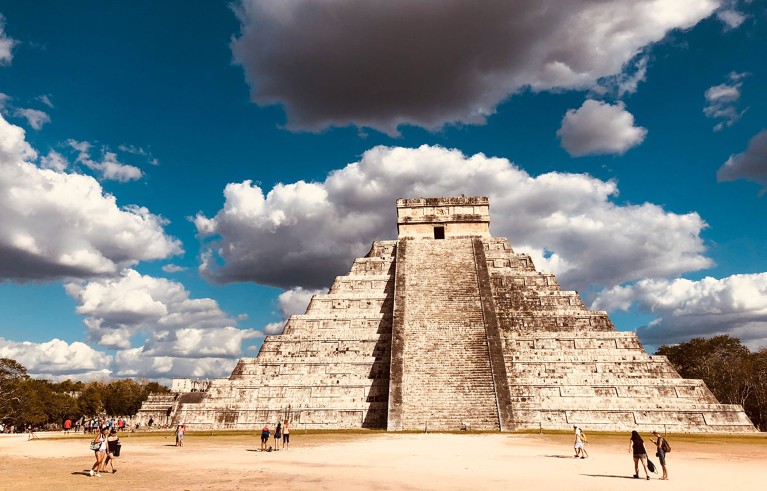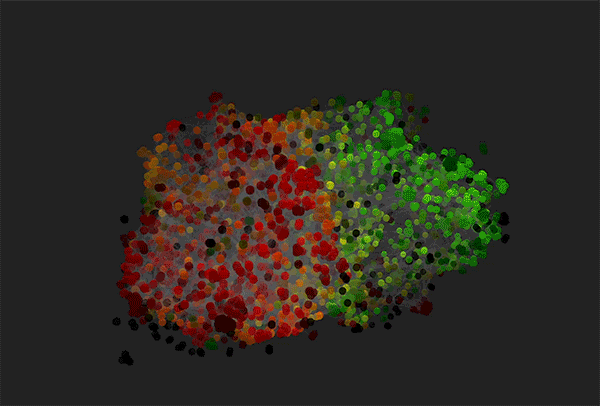Hello Nature readers, would you like to get this Briefing in your inbox free every day? Sign up here.

The Temple of Kukulcan is the largest Mayan structure in the ceremonial centre of Chichén Itzá in present-day Mexico.Credit: Johannes Krause
A genetic analysis of dozens of children and babies that were sacrificed between 900 and 1,400 years ago at the Maya metropolis Chichén Itzá has revealed that they were all boys. Of 64 skulls recovered from an underground chamber, one-quarter belonged to close relatives — probably siblings or cousins — and there were two pairs of identical twins. “This was very, very astonishing,” says anthropologist and study co-author Oana Del Castillo-Chávez. Ritual child sacrifice seems to have been a regular event at the time, but there was no previous evidence of close relatives, being sacrificed, she explains.
In sleep-deprived rats, a crucial brain signal linked to memory deteriorates, which could help to explain why broken sleep disrupts memory formation. The signal, called the sharp-wave ripple, seems to be particularly important for transforming short-term memories into long-term ones. Even a night of normal slumber after a poor night’s sleep wasn’t enough to completely fix the rats’ brain signal.
A test that reveals within 45 minutes which antibiotic works against a bacterial urinary tract infection (UTI) has won the Longitude Prize. It usually takes a few days to find out if a UTI is caused by bacteria, as opposed to viruses or even fungi, and which antibiotic it’s susceptible to. An infection is often treated preemptively with antibiotics, which drives antibiotic resistance. It took a decade to find a winner for the £8 million prize, which sought a quick and easy-to-use test for bacterial infections. For now, the £25 test is too expensive for widespread use.
Features & opinion
The same mRNA technology that underpins COVID-19 vaccines could train the immune system to attack cancer cells. In a small trial, mRNA treatment in combination with an established immunotherapy nearly halved the risk of melanoma recurrence, compared with the immunotherapy on its own. “We have the first proof of concept that these things can work,” says cancer immunologist Cristina Puig-Saus. “Now, we just need to make them better.” Key to this will be to predict which of the cancer cells’ mutant proteins — unique to each person and cancer type — the vaccine needs to target.
There is evidence that open-access papers tend to garner more citations than non-open-access ones, but scientists in low-income countries seem to see relatively little of this benefit. Low-cost publishing options — such as journals and platforms that do not charge author or reader fees — don’t always get papers out at a brisk pace, which is important for studies to get traction, particularly in the life sciences. And inequalities that affect researchers in low-income countries most can undermine the open knowledge-sharing systems that exist.
The climate crisis can be solved if we’re willing to learn from previous planetary challenges, argues atmospheric chemist Susan Solomon in her book Solvable. Change happens when impacts are personal, perceptible and practical solutions are available — as was the case for the persistent pesticide DDT and ozone-destroying CFC refrigerants. Yet none of these problems was solved by overwhelming scientific evidence or public concern, says climate scientist and reviewer Friederike Otto. Governments tend to drag their feet and prioritise technological substitutions that preserve industry profits. That won’t be enough this time, Otto says. “Any solution must have human rights at its heart.”
Infographic of the week

Animated sequence of a 3D graph layout of a B-T cell complex.
A new optics-free technique called ‘molecular pixelation’ uses DNA-tagged antibodies to identify the relative location of proteins on single cells — such as in this B–T cell complex. Reference: Nature Methods paper
Eagle-eyed readers might recognize this amazing animation from last week — but I got some details wrong in the caption, so I wanted to be sure to update you. Apologies for the error! (Filip Karlsson et al/Nature Methods)
Today I’m reeling from the news that some plant-based cheese is just as tasty as the real thing — even according to chefs who specialize in wonders such as fresh mozzarella di bufala. Whether you’re looking for low-carbon choices or less lactose, that could be a game-changer.
As I tuck into a cheese plate created from seeds, legumes, microbes and yeast, the perfect accompaniment would be your feedback on this newsletter. Please let us know what you think at briefing@nature.com.
Thanks for reading,
Flora Graham, senior editor, Nature Briefing
With contributions by Gemma Conroy and Katrina Krämer
Want more? Sign up to our other free Nature Briefing newsletters:
• Nature Briefing: Microbiology — the most abundant living entities on our planet — microorganisms — and the role they play in health, the environment and food systems.
• Nature Briefing: Anthropocene — climate change, biodiversity, sustainability and geoengineering
• Nature Briefing: AI & Robotics — 100% written by humans, of course
• Nature Briefing: Cancer — a weekly newsletter written with cancer researchers in mind
• Nature Briefing: Translational Research — covers biotechnology, drug discovery and pharma

